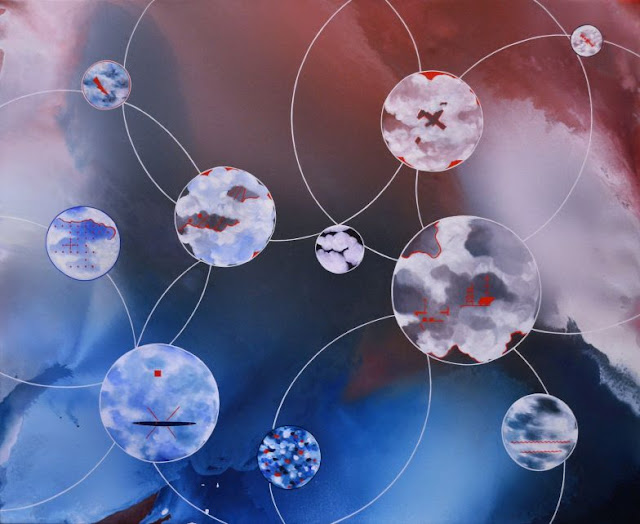Theatre of War: Dromo-Domain Oil on linen 90 x 100 cm 2021
CLAUSEWITZ
I think this is my 14th or 15th Theatre of War painting. I was inspired to start this ever-growing series by late 18th/early 19th century Prussian General, Carl Von Clausewitz's famous tome On War. He often mentions the term 'theatre of war'. Reading through the text, I get the impression he thought it involved a number of factors, but geography was a central theme.
I think about what 'theatre of war' might mean in the 21st century, the age of digital and cyber technology, drones, drone swarms, ubiquitous surveillance and increasingly autonomous systems. Regular readers will know I am probably a bit dystopian in my outlook. This is because I 'see' contemporary networked, interconnected and inter-operable technology as an homogenising and standardising force that enables the 'theatre of war' to extend not only beyond geography, but also traditional ideas of military activity and reach.* Because of the shared nature of technological platforms and systems I am particularly concerned about, and interested in, the militarise-ability of civilian technology. Here, increasing military interest in the electromagnetic spectrum [EMS] as an enabler of technology, a type of fires, a manoeuvre space and a domain is a key concern. Why? Because civilian technology also relies upon access to the EMS. Information and cyber warfare, and terms such grey-zone and hybrid warfare, all 'speak' to permeable military-civilian boundaries. I am also interested in the militarisation of imagination, time and speed. So, you can see, my ideas of the contemporary 'theatre of war' encompass almost - maybe all of- everything!
DROMO - SPEED
Theatre of War: Dromo-Domain is a visual spin on Paul Virilio's thoughts on speed and the term he coined, dromology ie: the logic of speed applied to contemporary society. Virilio, in a number of books and articles*, argued and observed that speed and accelerating speeds of technological operation and development play major roles in societal, political and geopolitical stability. As developments in networked and interconnected digital and cyber technologies have accelerated, light-speed [or near light-speed] signal transmissions introduce speed as a necessary advantage for both civilian and military technology. It is commercially, politically and militarily tactical to use speed as an advantage. One of my favourite quotes from Virilio is "The fact of having
reached the light barrier, the speed of light, is a historic event, one which
disorients history and also disorients the relation of human beings to the world.
If that point is not stressed, then people are being disinformed, they are
being lied to. For it has enormous importance. It poses a threat to geopolitics
and geostrategy.” (1)
HOW TO VISUALISE SPEED
I have grappled with how to visually convey speed as an overarching dromo-domain that encompasses civilian and military technology in a pervasive and persistent 'theatre of war' that extends from Earth to orbiting satellites.
In Theatre of War: Dromo-Domain I have repeatedly painted the symbol for light speed ie: c, to form a circle around the Earth. I love how the cs look like the spurs on a spinning cog, and that a sense of speed is created. The Earth is the 'pale blue dot'. This circle of cs represents the major satellite orbiting zones around the Earth. From these orbits to Earth, is our sphere of influence, where the EMS is harnessed for an array of communication, operative and inter-operative civilian and military technological functions. How are we managing this sphere of influence? I 'see' it as a volumetrically occupied and techno-colonised space.
In Theatre of War: Dromo-Domain the multiple overlapping white circles are indicative of civilian and military activities and domains. Clearly the term dual-use is inadequate in the era of speed, where networking, interconnectivity and interoperability scaffold us all in invisible webs of signals. This is a militarised space - a dromo-domain that enables and cradles more traditional military domains of land, sea and air. It is the meta-domain.
IMAGINATIONAL METAVEILLANCE
The cosmic-like background in Theatre of War: Dromo-Domain continues my quest to stimulate flight, your flight and mine [in imagination], to places where we can gain new perspectives. I call this 'imaginational metaveillance' - a kind of veillance that does not rely on EMS-enabled technology, thus it is untethered from it. The cosmic landscape also alludes to universal history, which includes the history of the EMS. All frequencies in the EMS are made up of photons, traveling in waves at light speed. The photon appeared around 10 seconds after the Big Bang. This kind of cosmological history really gets me thinking about how, in our sphere of influence, are we using a natural universal resource.
* Paul Virilio and Jean Baudrillard inform my ideas here.
Cheers,
Kathryn
PS. Related recent posts/paintings include:
(1) Paul Virilio, “Red
Alert in Cyberspace,” trans. Malcolm Imrie, Radical Philosophy (Nov/Dec 1995): 2.
* Just a small few examples of Virilio's work
Paul Virilio, Speed and Politics, first published 1977.
Paul Virilio, The Original Accident, trans. Julie Rose (2007
Paul Virilio, The Great Accelerator, trans. Julie Rose
(2012)


